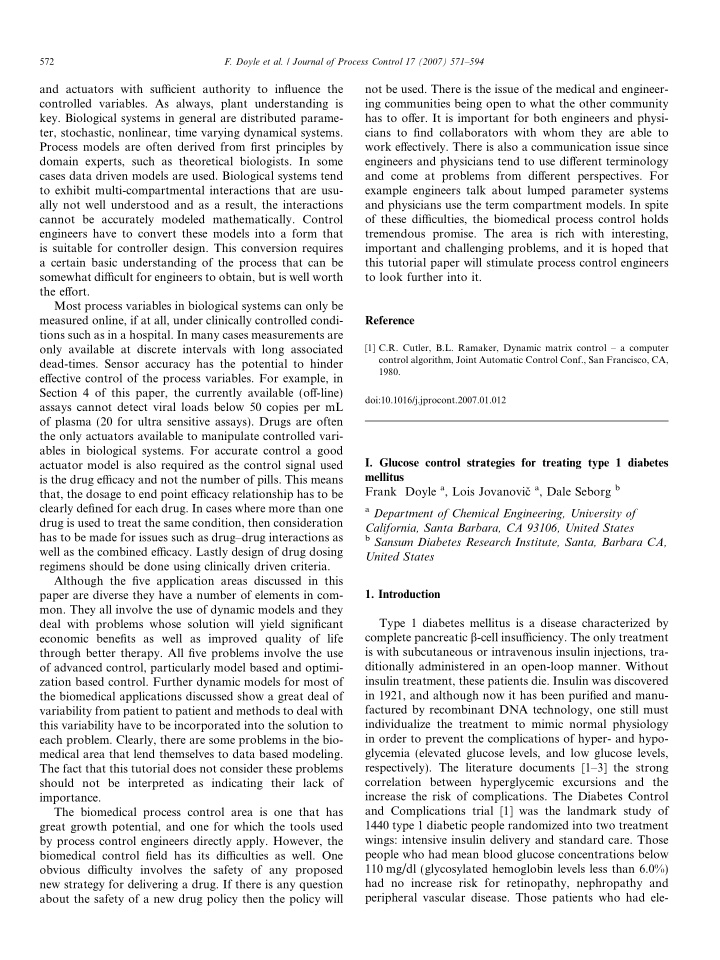



572 F. Doyle et al. / Journal of Process Control 17 (2007) 571–594 and actuators with sufficient authority to influence the not be used. There is the issue of the medical and engineer- controlled variables. As always, plant understanding is ing communities being open to what the other community key. Biological systems in general are distributed parame- has to offer. It is important for both engineers and physi- ter, stochastic, nonlinear, time varying dynamical systems. cians to find collaborators with whom they are able to Process models are often derived from first principles by work effectively. There is also a communication issue since domain experts, such as theoretical biologists. In some engineers and physicians tend to use different terminology cases data driven models are used. Biological systems tend and come at problems from different perspectives. For to exhibit multi-compartmental interactions that are usu- example engineers talk about lumped parameter systems ally not well understood and as a result, the interactions and physicians use the term compartment models. In spite cannot be accurately modeled mathematically. Control of these difficulties, the biomedical process control holds engineers have to convert these models into a form that tremendous promise. The area is rich with interesting, is suitable for controller design. This conversion requires important and challenging problems, and it is hoped that a certain basic understanding of the process that can be this tutorial paper will stimulate process control engineers somewhat difficult for engineers to obtain, but is well worth to look further into it. the effort. Most process variables in biological systems can only be measured online, if at all, under clinically controlled condi- Reference tions such as in a hospital. In many cases measurements are [1] C.R. Cutler, B.L. Ramaker, Dynamic matrix control – a computer only available at discrete intervals with long associated control algorithm, Joint Automatic Control Conf., San Francisco, CA, dead-times. Sensor accuracy has the potential to hinder 1980. effective control of the process variables. For example, in Section 4 of this paper, the currently available (off-line) doi:10.1016/j.jprocont.2007.01.012 assays cannot detect viral loads below 50 copies per mL of plasma (20 for ultra sensitive assays). Drugs are often the only actuators available to manipulate controlled vari- ables in biological systems. For accurate control a good I. Glucose control strategies for treating type 1 diabetes actuator model is also required as the control signal used mellitus is the drug efficacy and not the number of pills. This means Frank Doyle a , Lois Jovanovic ˇ a , Dale Seborg b that, the dosage to end point efficacy relationship has to be clearly defined for each drug. In cases where more than one a Department of Chemical Engineering, University of drug is used to treat the same condition, then consideration California, Santa Barbara, CA 93106, United States has to be made for issues such as drug–drug interactions as b Sansum Diabetes Research Institute, Santa, Barbara CA, well as the combined efficacy. Lastly design of drug dosing United States regimens should be done using clinically driven criteria. Although the five application areas discussed in this paper are diverse they have a number of elements in com- 1. Introduction mon. They all involve the use of dynamic models and they Type 1 diabetes mellitus is a disease characterized by deal with problems whose solution will yield significant complete pancreatic b -cell insufficiency. The only treatment economic benefits as well as improved quality of life is with subcutaneous or intravenous insulin injections, tra- through better therapy. All five problems involve the use ditionally administered in an open-loop manner. Without of advanced control, particularly model based and optimi- insulin treatment, these patients die. Insulin was discovered zation based control. Further dynamic models for most of in 1921, and although now it has been purified and manu- the biomedical applications discussed show a great deal of factured by recombinant DNA technology, one still must variability from patient to patient and methods to deal with individualize the treatment to mimic normal physiology this variability have to be incorporated into the solution to in order to prevent the complications of hyper- and hypo- each problem. Clearly, there are some problems in the bio- medical area that lend themselves to data based modeling. glycemia (elevated glucose levels, and low glucose levels, The fact that this tutorial does not consider these problems respectively). The literature documents [1–3] the strong correlation between hyperglycemic excursions and the should not be interpreted as indicating their lack of increase the risk of complications. The Diabetes Control importance. and Complications trial [1] was the landmark study of The biomedical process control area is one that has 1440 type 1 diabetic people randomized into two treatment great growth potential, and one for which the tools used wings: intensive insulin delivery and standard care. Those by process control engineers directly apply. However, the people who had mean blood glucose concentrations below biomedical control field has its difficulties as well. One 110 mg/dl (glycosylated hemoglobin levels less than 6.0%) obvious difficulty involves the safety of any proposed had no increase risk for retinopathy, nephropathy and new strategy for delivering a drug. If there is any question peripheral vascular disease. Those patients who had ele- about the safety of a new drug policy then the policy will
Recommend
More recommend